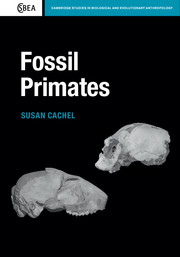Book contents
- Frontmatter
- Dedication
- Contents
- Acknowledgments
- Preface
- 1 Introduction: primates in evolutionary time
- 2 Primate taxonomy
- 3 Fossils and fossilization
- 4 The world of the past
- 5 The lifeways of extinct animals
- 6 Evolutionary processes and the pattern of primate evolution
- 7 Primate origins
- 8 The Paleocene primate radiation
- 9 The Eocene primate radiation
- 10 The Malagasy primate radiation
- 11 The Oligocene bottleneck
- 12 Rise of the anthropoids
- 13 The platyrrhine radiation
- 14 The Miocene hominoid radiation
- 15 The cercopithecoid radiation
- 16 Late Cenozoic climate changes
- 17 Conclusions
- References
- Index
9 - The Eocene primate radiation
Published online by Cambridge University Press: 05 April 2015
- Frontmatter
- Dedication
- Contents
- Acknowledgments
- Preface
- 1 Introduction: primates in evolutionary time
- 2 Primate taxonomy
- 3 Fossils and fossilization
- 4 The world of the past
- 5 The lifeways of extinct animals
- 6 Evolutionary processes and the pattern of primate evolution
- 7 Primate origins
- 8 The Paleocene primate radiation
- 9 The Eocene primate radiation
- 10 The Malagasy primate radiation
- 11 The Oligocene bottleneck
- 12 Rise of the anthropoids
- 13 The platyrrhine radiation
- 14 The Miocene hominoid radiation
- 15 The cercopithecoid radiation
- 16 Late Cenozoic climate changes
- 17 Conclusions
- References
- Index
Summary
The Eocene is a critical turning-point in primate evolution. During this epoch, the archaic plesiadapoid primates begin to go extinct, and primates of modern aspect, the euprimates, first appear. The Eocene expansion of the euprimates results in the founding of the major extant primate lineages: lorisiforms, lemuriforms, tarsiiforms, and anthropoids. These modern lineages are all traceable to Eocene ancestors. And, at the end of the Eocene, primates suffer a major decline—something that is also true for other mammalian orders. What was the Eocene crucible of primate evolution like? Details of Eocene climate and geography are well known (Figure 9.1).
The first 30 million years of the Cenozoic were very different from the present climate. Global temperatures were much higher than they are now, and the poles had no or virtually no ice. After the extreme temperature excursion at the Paleocene/Eocene boundary—the Paleocene/Eocene Thermal Maximum (PETM)—Eocene temperatures remained high and stable for a long time. Besides the PETM (Chapter 8), the Eocene experienced a less extreme rise in temperature at 53 mya, and temperatures remained constantly very high until 51 mya. In fact, the very warm and steady global climate between 53 and 51 mya is known as the Early Eocene Climatic Optimum (Zachos et al., 2008). The temperature of the earth slowly declined after this, but tropical habitats were widespread. The Gulf Coast at Laredo, Texas, was ringed with tropical rainforest and mangrove swamp, and therefore resembled the modern mangrove-laden coasts of Southeast Asia (Westgate, 2009). Global temperature peaked again at 42 mya, during the Middle Eocene (Zachos et al., 2008:Fig. 2). By the Late Eocene, temperatures had fallen enough to remove much of the tropical forests from Southern California, and about 40 percent of the non-carnivorous mammals—including primates—go extinct (Tomiya, 2009). Genera over 100 g in size with crushing, bunodont teeth increase in number, and the rodents proliferate. The terminal Eocene witnessed a drastic plummeting of temperature that severely affected mammal evolution, including the evolution of the primates (Chapter 11).
- Type
- Chapter
- Information
- Fossil Primates , pp. 136 - 154Publisher: Cambridge University PressPrint publication year: 2015



